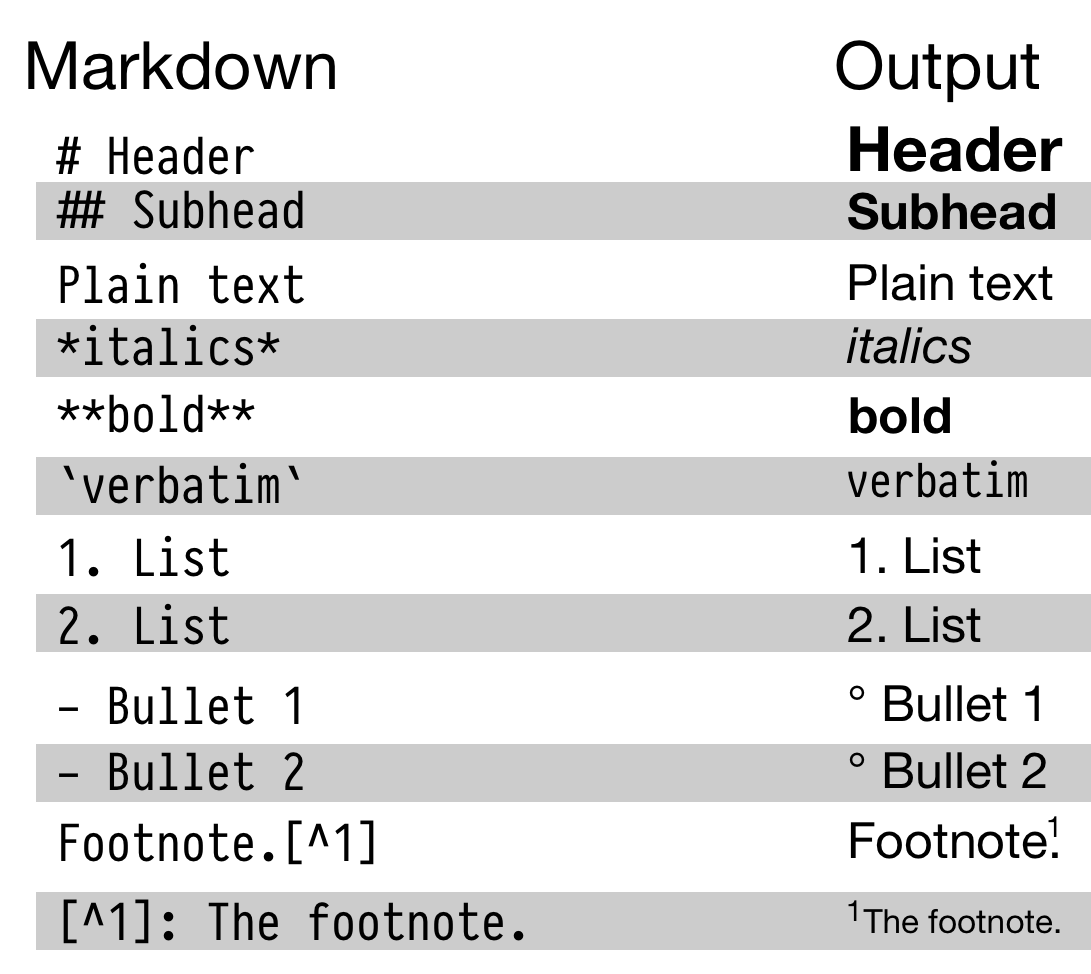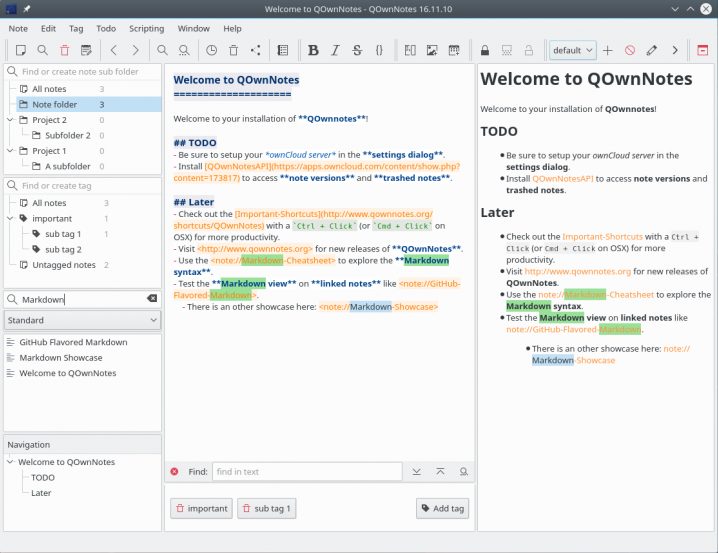- Nov 17, 2020 The best Markdown editor will make it easy to write your content and quickly export it to PDF, web pages, or Rich Text Format. You can work on any platform. Since there are dozens of really good Markdown editors for all platforms (Linux, Mac, Windows, web, etc.), you can pretty much write and edit text from any device and location.
- Collects to-do items in MarkDown files to an Explorer tree view with contextual menues for toggling and removing to-do items and keeps the tree view up-to-date as to-do items are inserted, updated and deleted in any MarkDown file in the workspace. See the feature rundown.
- Markdown List Indent
- Microsoft Word Markdown
- To Do List Markdown Software
- To Do List Markdown Example
- Markdown Bold
For everyone that has problems showing simple list, markdown need an Empty line before a list. This will not work. Item 1. Item 2. Item 3 The output will look something like this. This will not work. Item 1. Item 2. Item 3. To fix this; INSERT EMPTY LINE HERE, BEFORE LIST. Item 1. Item 2. Item 3. Should output like this.
When we read texts – whether online, in a newspaper or a printed book – we expect a certain format. Particularly important words are set in bold, a heading stands out from the rest of the test, and a structured list makes the text clearer. We consider this formatting to be obvious – and when we write a text on the PC ourselves, we can usually do so without any problems: from adjusting the font size and adding bullet points to making words bold. Any word processing program offers users a wide range of options for arranging their text.
But this is by no means a matter of course. Generally, in these situations you mark the text and the software then displays it how you wish. You don’t actually get to see the source text itself, including the markup elements (markers), with Word and similar programs. And if you did, you probably wouldn’t know what to do with it: This code can scarcely be read by people.
Languages like HTML or LaTeX can be written with any text editor, but they aren’t easy for people to decipher. The simplified markup language Markdown seeks to change exactly that. It wants the best of both worlds: to be understandable for both people and machines. Markdown uses self-explanatory elements to format the text. This means the text is relatively easy for people to read.

- Markdown tutorial: The right syntax for your documents
What is Markdown used for?
Just like HTML or LaTeX, Markdown is a markup language. In contrast to these examples, however, Markdown aims to be as easy as possible for people to read. Each markup element is closely related to the actual meaning, rather than being abstract. This can be shown most easily with an example: If you want to highlight a word in bold in HTML, you can either use the '<b>' or the '<strong>' tags.
If you write a document in LaTeX, use the element textbf (in continuous text mode).
Although both can be read relatively easily, they are harder to write – particularly when it comes to longer texts. Markdown simplifies this by marking bold passages with asterisks.
On the one hand, this version is easier to read as the asterisks make the bold text clear, and on the other hand, the four characters can be typed much quicker than tags. Even without converting (i.e. in plain text), a reader can easily determine what the author means – even without understanding the Markdown syntax.
This makes Markdown appealing particularly to users who don’t have a background in IT or web design skills, but still want to write texts for the internet regularly : for example, bloggers who work with a content management system (CMS). But even tech-savvy people resort to Markdown for writing simple texts. For instance, some programmers use the Markdown language to write supporting documents (e.g. readme files) that aren’t converted. Whether the user opens the text in a Markdown viewer or reads it in its raw state, there’s barely a difference in terms of readability.
For the most well-known CMSs like WordPress or Joomla, there are plugins that enable systems to understand Markdown. Many wikis, forums (such as reddit), and the website generator Jekyll can also work with the simplified markup language.
Markup languages are not considered to be programming languages. The former are only intended to define how a text is to be structured. Conversely, programming languages are characterized by loops and variables, forming the basis for writing software.
Markdown does not attempt to replace HTML – its creative possibilities are far too limited in any case. The developers of the language instead view Markdown as a complement. It’s possible to insert HTML elements into a Markdown document, thereby expanding the range of the relatively basic language. However, the Markdown language is intended primarily to simplify writing (especially online). When Markdown documents are converted by the parser, documents such as HTML documents are created to enable display in browsers.
The name “Markdown” is a play on words. Although a member of the “markup languages,” the name Markdown makes it clear that it concerns a down-scaled language.
Markdown tutorial: The right syntax for your documents
Since Markdown aims to be as simple a markup language as possible, the Markdown syntax is also virtually self-explanatory. Nonetheless, you first need to familiarize yourself with the markup elements before you can use it. We’ve compiled the most important functions for you.
Bold & italics
Markdown makes it especially easy to create bold and italicized text. Only asterisks are required to this end. To write in italics, add an asterisk before and after the word or words. For bold text, use two asterisks – and if you want a text to be both bold and italicized, three asterisks are necessary. Alternatively, you can use underscores.
Strikethroughs
In order to create a crossed-out text, use the tilde in Markdown twice in a row, followed by the respective text and then another two tildes.
Text can’t be underlined in Markdown. Although this is possible using the '<u>' tags in HTML, it’s usually inadvisable to do so. That’s because underlined text is used for hyperlinks online and it’s best to avoid confusing the two uses.

Headings
To create a heading in Markdown, a pound sign is typically used. It’s inserted with a space before the corresponding text. To create headings that are lower in the hierarchy and thus smaller, extra pound signs are added. This enables up to six levels of headings, just like in HTML.
Some users also insert pound signs after the headings. This can increase the readability but is not technically required. These signs are simply ignored in the conversion process.
Alternatively, equals signs and hyphens can be used to mark headings. These are inserted in the line below the actual heading. This option only allows you to create two different sizes of headings. One sign per heading is plenty, although multiple consecutive signs can often be seen. This is purely based on visual reasons since it looks as if the text is underlined once or twice.
Paragraphs
The Markdown language works with hard line breaks to separate paragraphs from each other. To create a completely new block of text (
tag), simply add an empty line. Important note: for Markdown, it’s sufficient if the line is visually empty. So if the line contains white spaces like tabs or spaces, the parser will ignore them and consider the line to be empty. If you want to create a line break like the
tag, add two spaces at the end of a line.
Quotes
In Markdown, quotes in a certain part of the text are indicated using a blockquote element. The greater-than sign is used for this purpose (>). You have the option to either mark each individual line with this sign or to insert it only at the beginning of the paragraph and to end the indented passage with an empty line. Additional formatting elements are possible in the blockquote element.
Markdown List Indent

Lists
To create an unsorted list in Markdown, you can use either the plus sign, the hyphen or an asterisk. All three ways produce the same result.
Conversely, a sorted list is generated by a number directly followed by a period.
Interestingly, the actual number is irrelevant in Markdown. Even if you write “first” three times or start with “third”, the Markdown language will always begin the list with the correct number.
Markdown also gives you the option of creating checklists. These appear with a box that can be activated by clicking on it. You can also add a checkmark when creating the list. To do so, insert square brackets and an X.
It’s important that you remember to leave a space between the square brackets for empty checkboxes. Otherwise, Markdown won’t recognize your text as a list.
Code
To mark a text as code in Markdown, a backtick – also known as an accent grave – is used (not to be confused with a simple quotation mark). The text is marked with a backtick at the start and end of the relevant passage. This enables source code or software commands to be incorporated directly into the running text.
When writing the code, take care not to accidentally insert an accent grave: à. This occurs automatically when you type a vowel after the sign. You can avoid this problem by first pressing the space bar after the backtick and then writing the vowel.
If a backtick is used in your code example itself, you can also use the sign twice at the beginning of the code section. In this case, Markdown will not interpret the simple backtick as an instruction.
To mark an entire block as source code, you can either use a tab or four spaces – for each line. You can indent the selected lines further by adding more tabs or spaces.

If you’d prefer to use signs to start and end code blocks, you can also mark the corresponding passage with three backticks at the start and at the end. Here you also have the option – at least with many Markdown editors – to create color highlights automatically. To do so, enter the language of the following source code after the three introductory backticks.
Images & hyperlinks
Markdown can likewise be used to integrate images and hyperlinks in your text. Both are created with a combination of square and round brackets. You can generate a link by placing the anchor text – i.e. the words or phrases visible in the text – in square brackets and inserting the URL in round brackets directly afterwards. If you’d like to give the hyperlink an optional title that the user can see in the mouseover, this is also possible: Enter the text in the round brackets, separated from the URL with a space and put in double quotation marks.
If you want to include a URL or an email address in the normal running text, most Markdown editors automatically create a clickable hyperlink. But to make sure this happens, you can insert a less-than and greater-than sign. To prevent this automatic editor feature, however, you should mark the URL as code and use backticks again.
As with hyperlinks, images can also be added to the Markdown document. To add images, start with an exclamation mark. Afterwards again insert square brackets which contain the alternative text for the image and round brackets with the image URL. This is then directly displayed in the text.
Of course, you can also link to HTML pages or images on your own server. If the current document is located on the same server, relative paths suffice.
Images and hyperlinks can also be combined. To create a clickable link behind an image, you can nest the two functions together. In this case, the image becomes the anchor text and thus appears in the square brackets.
Tables
Pipes (|) allow tables to be drawn in Markdown. Each cell is separated by a pipe. To create the header rows that are visually distinct from the rest of the content, you highlight the corresponding cells with hyphens.
In principle, it’s not important that the pipes are located one below the other. This only increases the readability when the Markdown document is viewed in its raw version. The same applies to pipes located to the side. These are likewise inconsequential for the compiling process.
Footnotes

Markdown gives you the option of inserting footnotes. You can write a reference number in the running text and link to the footnote at the end of the page – a corresponding line is created automatically. The reference number is also formatted as a hyperlink. Clicking on it leads directly to the relevant footnote. To use this automatic function, you should first insert the reference number after the respective word. In square brackets, you first write a circumflex and then the number.
The number you use (other terms are also possible) does not matter. Just like when creating lists, Markdown automatically performs the counting for you. However, it’s important that you correctly link to the reference again for the footnote. Add the same number to a new line with a circumflex in a bracket, insert a colon and then write the actual footnote. It can also be fully formatted and encompass multiple lines.
You can actually add the note anywhere in the text. Markdown will always display it at the end of the document. To close the note and return to the actual running text, insert an empty line.
& and <>
Since Markdown is closely related to HTML, the “and” symbol as well as the less-than and greater-than sign deserve special attention. These signs are used in HTML to open and close tags (<>) or to work with entities (&). But if you want to use the signs for their original purpose, they have to be masked in HTML: &, < and >. In general, there’s no reason in Markdown why you can’t use the signs “as they are”. However, since users have the possibility of mixing up Markdown with HTML, this is more complicated in practice. The parser understands when you want the simple characters and when you want HTML code so you don’t need to solve this problem yourself.
Microsoft Word Markdown
Backslash masking
Besides the specific characters involved in HTML, Markdown also uses certain symbols as markups. When you insert them, the parser will respond to them during conversion. This pertains to the following signs:
To Do List Markdown Software
- Asterisk: *
- Hyphen: -
- Underscore: _
- Round brackets: ()
- Square brackets: []
- Curly brackets: {}
- Period: .
- Exclamation mark: !
- Pound: #
- Accent grave: `
- Backslash:
To use these signs for their original purpose, simply add a backslash in front of them. Important: The backslash must be entered before each individual sign, i.e. before an opening bracket and before a closing bracket.
To Do List Markdown Example
Would you like to try Markdown yourself? Find out which program is right for your system in our article on Markdown editors.
Markdown Bold
